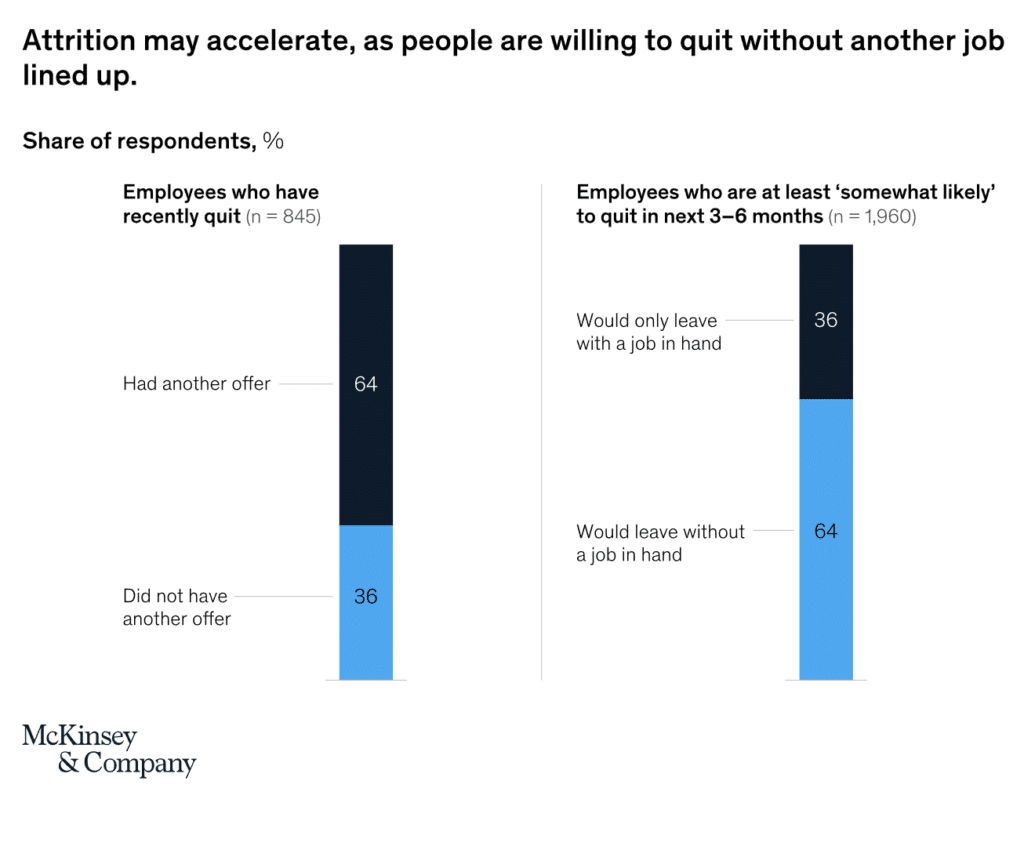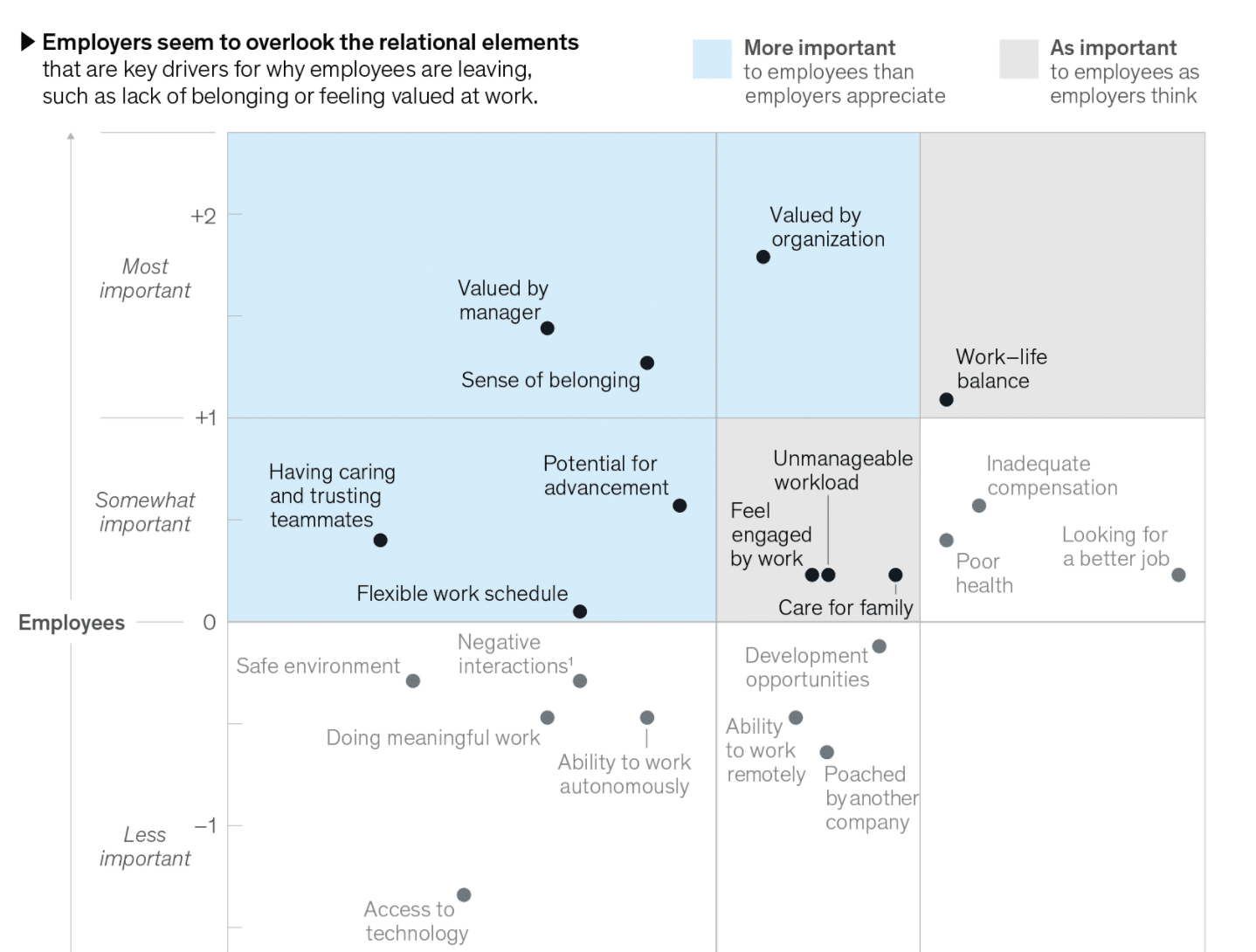

October 6, 2021
Culture of Chaos ,Uncategorized ,Vision
 This started out as a post about the Great Resignation. We may see most people exit the workforce for one reason or another.
This started out as a post about the Great Resignation. We may see most people exit the workforce for one reason or another.
People have become used to government payments, staying at home, and they’re unwilling to tolerate poor working conditions. Others are opposed to medical policies. And some are simply re-thinking their life. If they put their new checks into investments at the beginning of this year, then they really have flexibility.
So what does this mean?
And if you’re looking for a company engagement survey to save you, you’re about six months too late.
Now… don’t panic.
Why? Well for one, it never works. No one ever looked back and said, “I’m glad I completely freaked out and lost my shit over that.” If anything, it’s the actions they took as a result that made the difference.
It reminds me of a story about big wave surfers. When they are under a 60 foot wave, and can’t get back to the surface, they may be pummeled by yet another wave. And even though they can hold their breath for five minutes, it still might not be enough. So what’s the first thing they do? Relax.
Yes, relax. Because it’s a simple equation. If they freak out, then their heart beats fast and uses up all of their oxygen then they’ll die. The only chance they have to survive, is to be calm. So point 1…
You secure your own mask before helping your baby. Why? So you don’t pass out in the process. Take a look at your own life. Are you taking care of the basics. That really comes down to eat, sleep and exercise. Establish your baseline, so that you can get a clear emotional perspective.
The second reason not to panic is because things are far worse than you think. (Didn’t see that coming, did you?). Yes, we’re talking a sea of converging issues – A potential global debt collapse. Supply line issues that could leave people starving. Tense foreign. A President who isn’t “all there.” I could go on… In other words, we’re in a cesspool of struggle with no strong leadership.
So why on Earth would I turn up the pain on you this way?
Because a slow boiling frog dies. Turn up that burner and the frog jumps out. So let me say the second step, which you might find familiar.
What this means is a very personal choice. But make the choice. It can be as little as having a couple months of food and water, or it can mean all out prepper survival. The big question is really, what would help you sleep at night? For me, it’s a few things:
a) Three months of food and water
b) Back-up generator
c) Cash on hand
d) Taking money out of the market and into gold
e) Personal protection
Depending on who reads this, this will sound like too much or too little. But the question is this:
As a leader, you want to get there, so that everything coming out of your communications is from a place of confidence in your own safety so that you can give that safety to others.
You may even consider sharing your plans or helping them do the same. We have a lot of loyalty to those who truly look out for us.
Most of what your people are thinking is either happening between employees, or even worse, in their own heads. Much like the way you gain control of a car by turning in the direction of the skid, you want to actually want to authorize and create space for these conversations. The best tool I know for this is open space, or on a small team, it’s called lean coffee.
All it takes is a simple question and the freedom and safety to have any conversation. The question could be as focused as hitting a key crucial target, or as simple as
“What do we do now?” or “How can we be ready for anything?”
The amount of relief alone from talking this freely will do wonders.
Beyond that, people make new connections, and have new ideas you wouldn’t have even imagined. This is a far different experience than what they’re used to: Sitting in a conference hall in the dark while executives give an “inspiring” speech about the future.
Luckily, most of the things people want are within your control. (See that upper left corner)

You’ll get to read the results of these sessions and see which ones you want to empower. You’ll see what experiments you can run. You can consider new pivots in products or business lines. (Contact me about “How to Disrupt an Industry” if you’d like to know more).
It’s time we realized that life is not going back to normal. Even once the chaos ends, we’re looking at a new world by the end of this chaos.
Does this scare you? Good. Let’s turn that fear into excitement.
June 1, 2020
Uncategorized
There’s a reason we never had a Chief Culture Officer at Zappos. Tony Hsieh, CEO said it’s everyone’s responsibility. The moment we elect one person in charge of it, people can assume it’s being done without their efforts. That’s far different from a CFO. It’s good to have someone stress the money so that everyone else can do their jobs.
Now that everything is going virtual (including big companies like Twitter telling their people they don’t have to come back to the office), there is a new need emerging.
When we lose the office, we lose a real sense of place that connects us. Imagine if your family suddenly went virtual. Your spouse and kids all in separate buildings, only connecting on Zoom. Think it would feel different? It would change your whole sense of identity.
That means the glue that’s holding a company together is communication itself.
That’s why I believe enterprises will need a new C-Level position:
Chief Communications Officer
Many companies already have someone in this position at the director, or VP level, but there’s a problem in that. This person is usually stressed out because they don’t have a team and they have to deliver tough messages, all while being positive enough to keep their job. They also don’t have the level of authority they need to be properly respected, and thus end up playing politics far more than they need to.
At the C-level, this person would have the following responsibilities:
Advise CEO to C suite communications
Advise CEO to board communications
Facilitate C suite group discussions
Craft messages from C suite to upper/mid management
Work with mid management to craft message to supervisors and front line
Set company wide communication standards and protocols
Educate the company on virtual communication
Set the tone of appropriate humor
This is all the WHAT.
But what’s also important is the HOW, because the game has changed. This is no longer about long emails that people never read. We are now in the Instagram TikTok age. I saw this coming early on at Zappos – People realized that messages would not necessarily get read when they were sent out to the whole company. So they would include funny images that get people’s attention.
This Chief Communications Officers would direct the graphic designers, photographers, video producers and writers to create:
Short form video
Infographics
Memes
Virtual events
Scoreboards / Dashboards
Short impactful emails
Internal Podcast
More that I haven’t even thought of.
When disruption is happening as quickly as it is, it’s time to make bets based on the intersection of our values and trends.
December 27, 2019
Uncategorized

This hack comes from the brilliant business coach, Cindy Ertman. It’s the answer to the question, “How do you get the real story from a reference when you’re hiring?”
It’s a dilemma for the reference, because they want to be helpful, but they don’t want to share the person’s weaknesses for fear of keeping the candidate from getting the job. So how do you hack that?
Culture hacks are in language…
Boom. They’re about to tell you the candidate’s weakness.
This is a true test to see if they’re a quality hire. If there’s any hesitation to say yes, you know what the answer is.
Part of the culture hacking process is to find the vulnerabilities within a system and the new hire process is very vulnerable because you could get someone who makes your life easy, or tanks the company from gross negligence. These culture hacks will make sure you see early warning signs.
December 6, 2019
Uncategorized

5-Hour work days? The all-star of Deep Work, Cal Newport makes a compelling case in the Wall Street Journal.
This is actually how culture work began. Factories used to have long days with no vacations, until experimentation proved that having people work less can mean more. Working less meant more long-term work due to fewer injuries and thus lower turnover costs.
Could this be our future?
If you think this is all good news, it’s not as simple as less work. The companies that do it also add more discipline such as no social media or even phones during those highly focused hours.
As usual, don’t believe this or a anything I say! Test it out for yourself and use real-world data.
July 15, 2019
Uncategorized
This is a danger when you have too many priorities. It happens when the leaders believe and communicate that everything is important.
Because they create so many goals, people know that it’s simply impossible to reach them all at once, so they do one of two things:
The alternative is the Prime Directive.
What’s the one or two big things that will move the needle on everything else?
November 18, 2014
Uncategorized
What happens when you’re ready for a culture change, but you know that your company is not. What can a leader do or say in this position?
Once the culture standards (values) are determined, the leader must absolutely live by example. There’s no way around that. But that can take time. What can the leader do or say now?
First and foremost -share the why. Why a culture shift? Why do you want change? How will we all benefit.
Secondly, invite them to opt-out…
“In order to develop this culture, we have to change our behaviors. Now some of you are very excited about this and have wanted it for a long time. Others may be resistant. We’ll work through it together, but let me be absolutely clear – If you have the sense you do not want to be here, or you know in your heart that you are not giving 100% to your job, then I recommend you start considering other options while it’s still your choice.”
Setting standards can be very powerful – if you keep to them. And it’s actually a courtesy to let people know you will do that in advance so that they can choose their own future.